Autoclaving is a widely used and effective method of sterilization that involves the use of steam under pressure to kill or eliminate microorganisms, including bacteria, viruses, and spores.
AUTOCLAVING or AUTOCLAVE
Autoclaving is the most common method used for sterilizing surgical instruments. It accomplishes sterilization dependably without damage to most of the instrument
It is the best, safest and effective method of sterilization. It destroys the spore forming microorganisms. In this method, high temperature, pressure and humidity is used to destroy the bacteria
Mechanism of Autoclave
- In autoclaving, the sterilization is done by steam under pressure. In an autoclave water boils and its vapor pressure equals that of the surrounding atmosphere.
- When pressure increases inside a closed vessel the temperature at which boils also increases. Saturated steam has better penetrating power
- When steam comes into contact with a cooler surface, it condenses into water and given up its latent heat to that surface
Temperature: 121 degree celcius
Pressure: 15 pounds per square inch (PSI)
Time: 15-45 minutes
Instruments Used for Sterilization
- Surgical instruments
- Syringes and needles
- Linen including gowns
- Masks
- Abdominal swabs and dressing
General Instructions
- All articles must be clean and dry
- The wrapper and container should allow penetration of the steam into the article
- The drum should not be too full nor the contents arranged too compactly
- Cans and jars must be opened and turned to their sides so that steam can penetrate the contents
- The temperature and pressure of the steam must be 121 degree Celcius and 1.05 kg/cm2. So that it will kill all types of microorganisms
- The destruction of bacteria depends upon the length of time the articles are exposed to steam under pressure. The minimum time is 30 minutes
- While operating an autoclave, all the air in the chamber must be driven out and replaced by steam
- When the autoclaving is over, wait for half an hour to dry the materials
Autoclave Uses:
- Sterilization of Surgical Instruments:
- Autoclaves are commonly used in healthcare settings to sterilize surgical instruments, medical devices, and equipment.
- Laboratory Sterilization:
- Research laboratories use autoclaves for sterilizing glassware, media, and other laboratory supplies.
- Pharmaceutical Industry:
- Autoclaves are utilized in the pharmaceutical industry to sterilize production equipment and ensure the sterility of pharmaceutical products.
- Waste Disposal:
- Autoclaving is employed in the disposal of laboratory waste and certain medical waste to render it non-infectious.
- Food Industry:
- In the food industry, autoclaves may be used for canning and preserving food by eliminating harmful microorganisms.
Autoclaving Tips:
- Proper Loading:
- Items must be properly arranged to ensure effective steam penetration.
- Avoid overloading the autoclave to allow for adequate sterilization.
- Use of Indicators:
- Chemical and biological indicators are often used to monitor and confirm the effectiveness of the autoclaving process.
- Regular Maintenance:
- Autoclaves require regular maintenance to ensure proper functioning and calibration.


